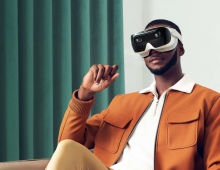
VR Headset Market Rebounds, AR Headset Market Also Saw Positive Movement
The combined Augmented Reality (AR)/Virtual Reality (VR) headset market grew 9.4% year over year in the third quarter of 2018 (3Q18), according to IDC.
The market research firm said that the VR headset market returned to growth in 3Q18 after four consecutive quarters of decline and now makes up 97% of the combined market. Global shipments for VR headsets reached 1.9 million units in the quarter, up 8.2% from 3Q17, as extensive discounts on existing products and interest in new ones led to shipment gains in both the consumer and commercial markets.
"On the consumer front, the combination of lower prices and increased content is beginning to resonate with users. Meanwhile, commercial adoption is also on the rise for a range of use cases, including training, design, and showcasing," said "The VR market is finally starting to come into its own," said Jitesh Ubrani senior research analyst for IDC Mobile Device Trackers.
During the quarter, screenless viewers such as Samsung's Gear VR declined 58.6% as product discounts and availability have dried up. Some of Samsung's latest phones further exaggerate the issue as they are not compatible with the current version of the headset. Besides Samsung, other prominent brands such as Google and Alcatel have also significantly scaled back their efforts.
Meanwhile, standalone headsets grew 428.6% and accounted for 20.6% of the VR headset market. Facebook's Oculus Go and Xiaomi's Mi VR – the same headset, shipped into different markets by the two companies – together shipped nearly a quarter million headsets worldwide, making it the most popular standalone headset by a wide margin.
Tethered VR headsets surpassed 1 million units for the second time ever, making 3Q18 the best third quarter on record. Sony shipped 463,000 PSVR headsets during the quarter followed by Oculus with 300,000 and HTC with 230,000. However, Oculus managed to be the top vendor in the overall VR headset market thanks to the popularity of the Go as well as the Rift, capturing 25.9% of the entire VR market. Total Oculus shipments were 491,000 during the quarter, excluding the Xiaomi Mi VR.
Outside the VR headset market, AR headsets also fared well during the quarter. Lenovo captured the top spot with 23,000 headsets shipped. Most of that volume was comprised of the Star Wars Jedi Challenges headset, which is targeted at the consumer audience. When excluding this headset, the AR headset market grew 1.1% over the previous year thanks to brands such as Vuzix and Epson. Though Microsoft's Hololens was still one of the most popular AR headsets, growth has slowed as many customers await the next generation headset that is expected to launch in 2019.





















